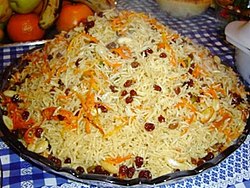This article may require cleanup to meet Wikipedia's quality standards. The specific problem is: Too many bullet points like a list, instead of sentences and paragraphs. Also needs better organization between 'Staple foods', 'Drinks' etc. Needs more encyclopedic content instead of current catalog-like format.(November 2021) |
| Part of a series on the |
| Culture of Afghanistan |
|---|
 |
| History |
| People |
| Languages |
| Mythology |
| Cuisine |
| Festivals |
| Religion |
| Sport |
Afghan cuisine is influenced by Persian, Turkish, Central Asian and South Asian cuisines due to Afghanistan's close proximity and cultural ties. [1] [2] The cuisine is halal and mainly based on mutton, beef and poultry with rice and Afghan bread. Accompanying these are common vegetables and dairy products, such as milk, yogurt, whey, [3] and fresh and dried fruits such as apples, apricots, grapes, bananas, oranges, plums, pomegranates, sweet melons, and raisins. [4] The diet of most Afghans revolves around rice-based dishes, while various forms of naan are consumed with most meals. [5] Tea is generally consumed daily in large quantities, and is a major part of hospitality. [6] The culinary specialties reflect the nation's ethnic and geographic diversity. The national dish of Afghanistan is Kabuli palaw , a rice dish cooked with raisins, carrots, nuts, and lamb or beef. [7]

















